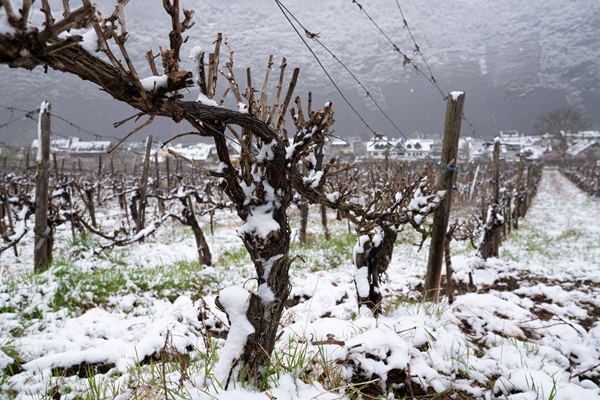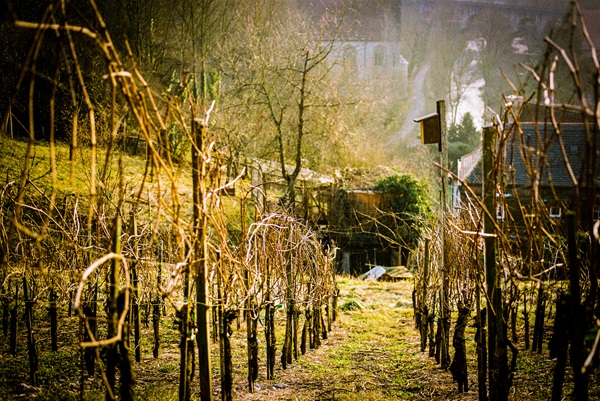Winter is a crucial period for vines, marking the start of a new viticultural year. During this cold season, the vines go into vegetative rest, an essential phase in their regeneration and preparation for the coming spring.
But for your vines to survive and thrive, it’s vital to prepare them well. In this article, we’ll explore the best practices for preparing your vines for winter, from pruning to frost protection.
Discover how careful winter maintenance can ensure the health of your vines, prevent disease and lay the foundations for an abundant, quality harvest in the spring. Whether you’re an experienced winemaker or a gardening enthusiast, these tips will help you optimize your vines’ preparation for the cold season and get your vineyard ready for a promising new year.
Vine behaviour in winter
1. Sleeping and slowing down
In winter, the vine enters a phase of dormancy, a state of physiological rest in which its metabolic functions slow down considerably. This period of rest is crucial for the vine, enabling it to recuperate after the growing season and prepare for the new year. During dormancy, the vine stops growing, and the sap that was actively circulating in the shoots and branches during the growing season withdraws mainly to the roots. This metabolic slowdown is an essential adaptation to survive the low temperatures of winter.
2. Reduction of activities
With the cold weather and falling temperatures, the vine reduces its activity. Buds, the future grape clusters, also enter a resting phase. They are protected by an outer layer and are less sensitive to extreme weather conditions. The branches, or shoots, become rigid and less flexible, as the vine concentrates its resources and energy in the roots and trunk.
3. Frost protection
To cope with frost, vines have developed natural protection mechanisms. Sap, which contains sugars, acts as a natural antifreeze, reducing the risk of internal tissue freezing.
Dormant buds are less likely to be damaged by low temperatures, as they are in a more resistant state to extreme conditions. Young plants and vines, however, are more vulnerable and require special attention to avoid frost damage.

4. Cold adaptation
The vine’s roots are more resistant to cold than its aerial parts. They continue to absorb water and receive nutrients stored during the growing season, even when activity is much lower. This nutrient reserve helps the vine to restart growth in spring. The root system is also able to survive at lower temperatures than the aerial parts, which is crucial for the vine’s survival throughout the winter.
5. Preparing for spring
During winter, the vine subtly prepares itself for the growing season to follow. The buds, though inactive, accumulate energy reserves and prepare to hatch when temperatures begin to warm in spring. The gradual return of sap to the branches marks the beginning of renewed growth, heralding the start of the vegetative cycle for a new year.
How to prepare vines for winter?
Preparing vines for winter is essential to ensure their survival and a good harvest of quality grapes the following spring. Here are our simple and effective tips to help you (even beginners) understand how to effectively protect your vines during this critical period.
1. Vine pruning

Proper vine pruning prevents the accumulation of moisture around the shoots, thus reducing the risk of disease. Correct pruning encourages the formation of fruiting buds for the next harvest. What’s more, careful pruning helps vines to start growing in spring with renewed vigor.
Pruning techniques
There are several techniques for pruning vines, each with its own advantages:
-
Formative pruning: this type of pruning is carried out when a vine is young and aims to define its structure. Young plants are pruned to establish the main branches and form the vine stock. In France, goblet or cordon pruning is often used to establish a good initial structure.
-
Fruiting pruning: this is pruning carried out every year to encourage grape production. It consists in reducing the number of shoots while retaining a few promising buds. The technique generally consists in keeping 2 to 4 buds per shoot, which ensures a good balance between fruit production and vine vigor.
-
Renewal pruning: for older vines, renewal pruning involves replacing old shoots with new ones. This helps maintain good grape quality and constant production by removing worn branches.
When to prune vines
- Autumn: after harvest and before the first frosts.
- Early winter: pruning too late could expose vines to the risk of frost.
To avoid damage caused by frosttake the following precautions:
- Don’t leave wood bare: cuts should be clean and smooth. Avoid leaving bare ends of wood that could be exposed to frost.
- Protect young plants: use mulch or other protection to insulate young plants and prevent cold damage.
After pruning, monitor the vines for any signs of disease or damage. Make sure that the cuttings are protected and that the soil around the vines is well tended to prepare the vines for effective spring growth.
2. Preparing vineyard soil for winter
Cleaning and waste management
Before winter arrives, it’s essential to prepare the soil around the vines by clearing away the season’s residues. After harvesting, be sure to remove fallen leaves and debris from around the vines, as dead leaves can harbor diseases or pests. If you’ve already pruned the vines in autumn, don’t forget to pick up the cut shoots to prevent them from becoming breeding grounds for disease or infestation.
Working the soil
Tillage before winter helps prepare the soil for cold temperatures and improves root health:
- Aerate the soil: use a hoe or cultivator to aerate the soil around the vines. This helps reduce soil compaction, improve drainage and prevent the accumulation of water that could freeze.
- Light spading: light spading can help mix organic residues with the soil, improving its structure and ability to absorb water.
Frost protection
To protect vine roots from extreme temperatures:
- Use mulch: apply a layer of organic mulch (such as wood shavings or straw) around the vines. This helps insulate the roots against the cold and maintain a more stable soil temperature.
- Avoid water accumulation: make sure the soil is well drained to prevent water from accumulating and freezing, which could damage the roots.
- Installation of anti-freeze towers : Antifreeze towers are structures designed to protect vines from frost. They work by creating a warmer microclimate around the vines, capturing radiant heat from the ground and radiating it back to the plants.

